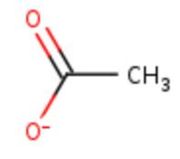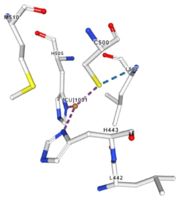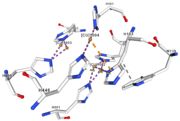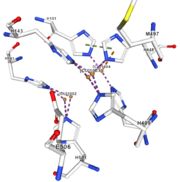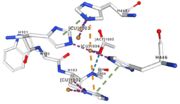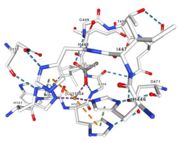User:Estelle Blochouse/ Sandbox 1497
From Proteopedia
(Difference between revisions)
| Line 13: | Line 13: | ||
Multicopper oxidase might also be involved in the regulation of metal transport. | Multicopper oxidase might also be involved in the regulation of metal transport. | ||
| - | Multicopper oxidases are abble to oxiise their substrate. They accept an electron in the <scene name='pdbligand=CU:COPPER+(II)+ION'>mononoclear copper center</scene> and transfer it to the trinuclear copper centre. The dioxygen bind to the trinuclear center and recieve four electron. It is transformed into two molecules of water.<ref> | + | Multicopper oxidases are abble to oxiise their substrate. They accept an electron in the <scene name='pdbligand=CU:COPPER+(II)+ION'>mononoclear copper center</scene> and transfer it to the trinuclear copper centre. The dioxygen bind to the trinuclear center and recieve four electron. It is transformed into two molecules of water.<ref>Bento I, Martins LO, Gato Lopes G, Arménia Carrondo M, Lindley PF, title = Dioxygen reduction by multi-copper oxidases; a structural perspective, November 2005</ref> Three copper centres exist that can be differentiate spectroscopically: Type 1 or blue (<scene name='pdbligand=CU:COPPER+(II)+ION'>mononoclear copper center</scene>), type 2 or normal (Cu1004) and type 3 or coupled binuclear (1002 and 1003).<ref>Messerschmidt A, Huber R, title = The blue oxidases, ascorbate oxidase, laccase and ceruloplasmin. Modelling and structural relationships, journal = Eur. J. Biochem. volume = 187, January 1990</ref><ref>authors = Ouzounis C, Sander C, title = A structure-derived sequence pattern for the detection of type I copper binding domains in distantly related proteins, journal = FEBS Lett. volume = 279, February 1991</ref> |
| Line 23: | Line 23: | ||
== Structural highlights == | == Structural highlights == | ||
<table><tr><td colspan='2'>Multicopper Oxidase CueO [[4e9s]] is a protein containing one chain with sequence from [http://en.wikipedia.org/wiki/Ecoli Ecoli]. Full crystallographic information is available from [http://oca.weizmann.ac.il/oca-bin/ocashort?id=4E9S OCA]. For a <b>guided tour on the structure components</b> use [http://oca.weizmann.ac.il/oca-docs/fgij/fg.htm?mol=4E9S FirstGlance]. <br> | <table><tr><td colspan='2'>Multicopper Oxidase CueO [[4e9s]] is a protein containing one chain with sequence from [http://en.wikipedia.org/wiki/Ecoli Ecoli]. Full crystallographic information is available from [http://oca.weizmann.ac.il/oca-bin/ocashort?id=4E9S OCA]. For a <b>guided tour on the structure components</b> use [http://oca.weizmann.ac.il/oca-docs/fgij/fg.htm?mol=4E9S FirstGlance]. <br> | ||
| - | </td></tr><tr id='ligand'><td class="sblockLbl"><b>[[Ligand|Ligands:]]</b></td><td class="sblockDat"><scene name='pdbligand=ACT:ACETATE+ION'>Acetate ion</scene>[[Image:Act.jpg|thumb|middle|'''Figure 1:''' Acetate ion.<ref> | + | </td></tr><tr id='ligand'><td class="sblockLbl"><b>[[Ligand|Ligands:]]</b></td><td class="sblockDat"><scene name='pdbligand=ACT:ACETATE+ION'>Acetate ion</scene>[[Image:Act.jpg|thumb|middle|'''Figure 1:''' Acetate ion.<ref><span class='plainlinks'>[https://www.rcsb.org/structure/4e9s RCBS PDB]</span></ref>]], <scene name='pdbligand=CU:COPPER+(II)+ION'>Copper</scene></td></tr> |
<tr id='related'><td class="sblockLbl"><b>[[Related_structure|Related:]]</b></td><td class="sblockDat">[[4e9p|4e9p]], [[4e9q|4e9q]], [[4e9r|4e9r]], [[4e9t|4e9t]]</td></tr> | <tr id='related'><td class="sblockLbl"><b>[[Related_structure|Related:]]</b></td><td class="sblockDat">[[4e9p|4e9p]], [[4e9q|4e9q]], [[4e9r|4e9r]], [[4e9t|4e9t]]</td></tr> | ||
<tr id='gene'><td class="sblockLbl"><b>[[Gene|Gene:]]</b></td><td class="sblockDat">cueO, yacK, b0123, JW0119 ([http://www.ncbi.nlm.nih.gov/Taxonomy/Browser/wwwtax.cgi?mode=Info&srchmode=5&id=83333 ECOLI])</td></tr> | <tr id='gene'><td class="sblockLbl"><b>[[Gene|Gene:]]</b></td><td class="sblockDat">cueO, yacK, b0123, JW0119 ([http://www.ncbi.nlm.nih.gov/Taxonomy/Browser/wwwtax.cgi?mode=Info&srchmode=5&id=83333 ECOLI])</td></tr> | ||
| Line 40: | Line 40: | ||
<table><tr><td colspan='2'>In the chain, 5 ligands are present: an acetate ion (C2H3O2) and 4 copper ions. <br> | <table><tr><td colspan='2'>In the chain, 5 ligands are present: an acetate ion (C2H3O2) and 4 copper ions. <br> | ||
| - | </td></tr><tr><td>[[Image:Cu1001.jpg|thumb|left|'''Figure 2:''' Copper 1001<ref> | + | </td></tr><tr><td>[[Image:Cu1001.jpg|thumb|left|'''Figure 2:''' Copper 1001<ref><span class='plainlinks'>[https://www.rcsb.org/structure/4e9s RCBS PDB]</span></ref>]]</td><td>Cu1001: The copper ion is bound thanks to 3 metal protein interactions with H443, H505 and C500, structure stabilised by L502, M510 by hydrogen bonds</td></tr> |
| - | <tr><td>[[Image:Cu1002.jpg|thumb|left|'''Figure 3:''' Copper 1002<ref> | + | <tr><td>[[Image:Cu1002.jpg|thumb|left|'''Figure 3:''' Copper 1002<ref><span class='plainlinks'>[https://www.rcsb.org/structure/4e9s RCBS PDB]</span></ref>]]</td><td>Cu1002: 2 atoms of Cu, bonds twice by metal interaction (2x3) with 3 histidine : H501, H103, H141 stabilised by hydrophobic contact with W139</td></tr> |
| - | <tr><td>[[Image:Cu1003.jpg|thumb|left|'''Figure 4:''' Copper 1003<ref> | + | <tr><td>[[Image:Cu1003.jpg|thumb|left|'''Figure 4:''' Copper 1003<ref><span class='plainlinks'>[https://www.rcsb.org/structure/4e9s RCBS PDB]</span></ref>]]</td><td>Cu1003: 2 CU bond with 3histidine : H499, H143, H448 by 2 metal interactions. h448 is stabilised by Pi interactions with [CU]1004 and H101</td></tr> |
| - | <tr><td>[[Image:Cu1004.jpg|thumb|left|'''Figure 5:''' Copper 1004<ref> | + | <tr><td>[[Image:Cu1004.jpg|thumb|left|'''Figure 5:''' Copper 1004<ref><span class='plainlinks'>[https://www.rcsb.org/structure/4e9s RCBS PDB]</span></ref>]]</td><td>Cu1004: one single atome of CU bonds once by metal interactions with 2 H ( and one ACT[1005]) : H101 and H446 stabilised by Pi interactions with H103 and H448. [CU]1004 has Pi interactions with H103 and H448. H113 and H446 Pi interactions</td></tr> |
| - | <tr><td>[[Image:Act10051.jpg|thumb|left|'''Figure 6:''' Acetate ion 1005<ref> | + | <tr><td>[[Image:Act10051.jpg|thumb|left|'''Figure 6:''' Acetate ion 1005<ref><span class='plainlinks'>[https://www.rcsb.org/structure/4e9s RCBS PDB]</span></ref>]]</td><td>ACT[1005]: is linked by hydrogen bonds to G104 and G449</td></tr> |
</table> | </table> | ||
Revision as of 14:50, 11 January 2019
Multicopper Oxidase CueO (4e9s)
| |||||||||||
References
- ↑ EMBL-EBI, Family: Cu-oxidase (PF00394), Summary: Multicopper oxidase, http://pfam.xfam.org/family/Cu-oxidase
- ↑ UniProtKB
- ↑ Bento I, Martins LO, Gato Lopes G, Arménia Carrondo M, Lindley PF, title = Dioxygen reduction by multi-copper oxidases; a structural perspective, November 2005
- ↑ Messerschmidt A, Huber R, title = The blue oxidases, ascorbate oxidase, laccase and ceruloplasmin. Modelling and structural relationships, journal = Eur. J. Biochem. volume = 187, January 1990
- ↑ authors = Ouzounis C, Sander C, title = A structure-derived sequence pattern for the detection of type I copper binding domains in distantly related proteins, journal = FEBS Lett. volume = 279, February 1991
- ↑ RCBS PDB
- ↑ RCBS PDB
- ↑ RCBS PDB
- ↑ RCBS PDB
- ↑ RCBS PDB
- ↑ RCBS PDB
- ↑ Kataoka K, Komori H, Ueki Y, Konno Y, Kamitaka Y, Kurose S, Tsujimura S, Higuchi Y, Kano K, Seo D, Sakurai T. Structure and function of the engineered multicopper oxidase CueO from Escherichia coli--deletion of the methionine-rich helical region covering the substrate-binding site. J Mol Biol. 2007 Oct 12;373(1):141-52. Epub 2007 Aug 2. PMID:17804014 doi:10.1016/j.jmb.2007.07.041
